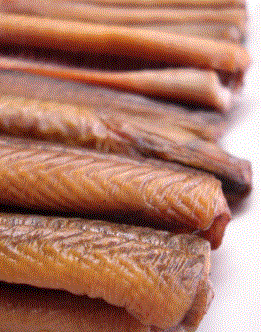Smoked eel byproduct and omega-3 fatty acids
- eeliosbbqsauce
- Jun 19, 2018
- 1 min read
European eel (Anguilla anguilla) production has steadily increased over the last 30 years, mainly due to the expansion of farming, which accounts for more than 80% of the world’s consumption of the species (FAO, 2016). Greece shows important eel farming activity, following the Netherlands, Italy and Denmark. Eels are usually hot-smoked after brining or dry-salting, but the method differs considerably to suit local preferences. In Europe, eels are sold almost exclusively as skinned hot-smoked fillets. During filleting and prior to packaging, the fat is removed from the fillets (by-product).
The smoked eel byproduct is a mainly fatty (63.4%) rich in unsaturated fatty acids (a total of 45.1%). Of particular interest is the omega-3 fatty acid content (10.3%), while the total percentage of omega-3 fatty acids reaches 17% of the total fat content of the smoked eel. These results lead to the conclusion that it is a byproduct with significant potential for commercial exploitation. In recent decades there has been a commercial trend as well as a scientific interest of collection, analyzing and exploitation of byproducts (particularly in the fish processing industry, Figure I1.1a). The increasing recognition of the value of omega-3 fatty acids, with emphasis on EPA and DHA, has led to a change in the methods and sectors of exploitation of the fatty byproducts of the seafood industry. The increase in the quantity of fish oil intended for human consumption has opened up a significant market (20-25%) by upgrading the value of these products (Figure).






Comments